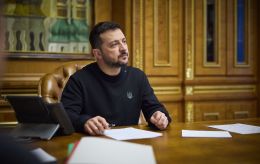Russia's planned breakthrough to thwart UAF's advance toward Bakhmut: frontline review
 Ukrainian Armed Forces continue advance toward Bakhmut (Photo: Vitalii Nosach, RBC-Ukraine)
Ukrainian Armed Forces continue advance toward Bakhmut (Photo: Vitalii Nosach, RBC-Ukraine)
About the attempts of Russians to break through the front in the Luhansk region, the situation near Bahmut, and in the south, as well as how strikes on objects in Crimea can affect the pace of the offensive - see more in the material by RBC-Ukraine.
Is the enemy breaking through the front?
The Russian offensive continues along the stretch from Kupiansk to Lyman. The Spokesperson of the Operational Command East of the Armed Forces of Ukraine, Serhii Cherevatyi, previously stated that the enemy has concentrated over 100,000 troops, 900 tanks, and 370 multiple rocket launchers in this area. Almost the same number of troops as the peak strength of the Soviet forces in Afghanistan in the 1980s.
Intense fighting has been ongoing for two weeks. As stated by the representative of the General Staff, Andrii Kovalov, the enemy is being held back, suffering significant losses, and resorting to deploying reserves. According to the DeepState project map, the situation for the Ukrainian Armed Forces is particularly dangerous near Svatove, at the junction of the Kharkiv, Luhansk, and Donetsk regions, near the village of Karmazynivka.
Here, Russia has expanded its foothold on the western bank of the Zherebets River and is penetrating up to 5 kilometers into Ukrainian defenses. According to the portal's data, the Russians seem to have taken control of the populated areas of Novoiehorivka, Serhiivka, and Nadiia.
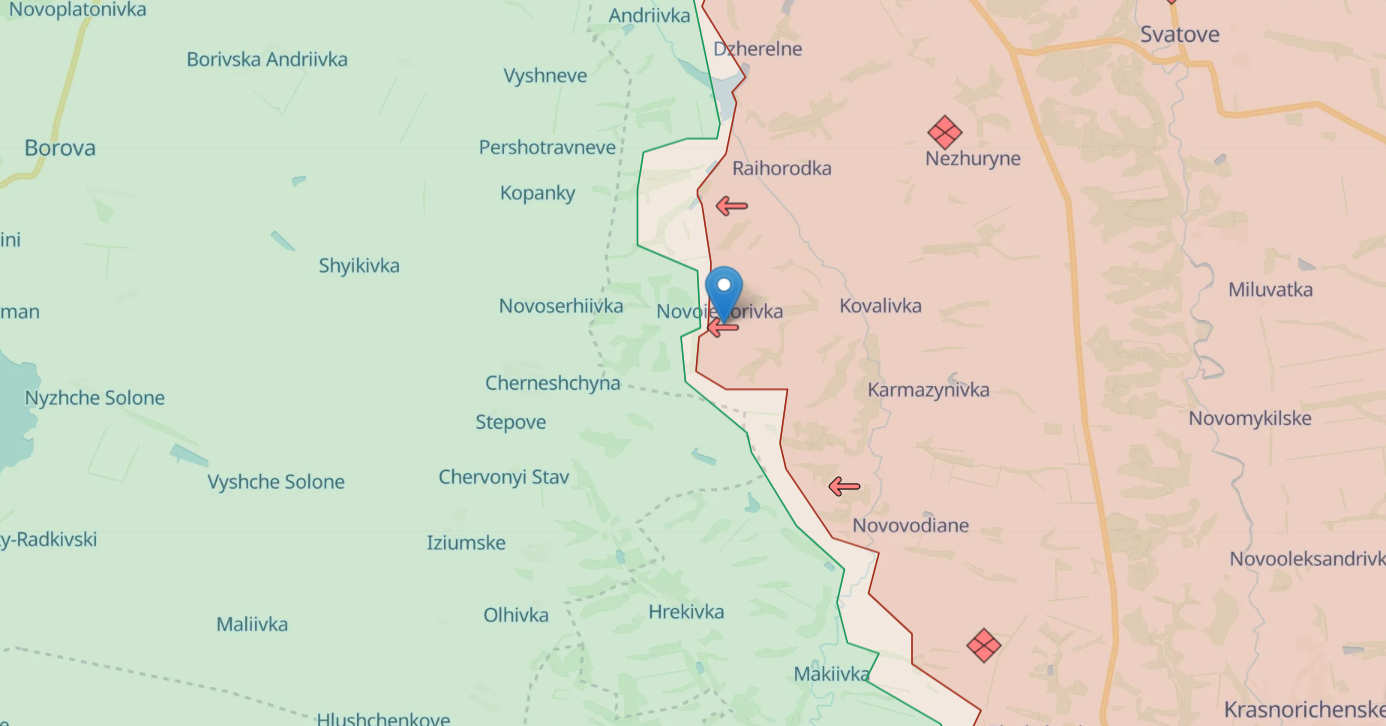 The Russians may have taken control of three villages near Svatove, but the Ukrainian side denies this (photo: deepstatemap.live)
The Russians may have taken control of three villages near Svatove, but the Ukrainian side denies this (photo: deepstatemap.live)
The Russian Ministry of Defense spoke of taking the villages and advancing up to 2 kilometers. However, experts from the Institute for the Study of War (ISW) have not found visual confirmation of this information. Ukrainian representatives also deny losing territory.
"The tactical situation there has not significantly changed," Cherevatyi said in a CNN comment.
It appears that the occupiers are trying to advance towards the Oskil River and at least create a buffer zone around the Luhansk region. It is worth noting that the full capture of this region was declared one of the goals of the Russian-Ukrainian war. Apparently, the adversary aims to reach the Oskol Reservoir, occupy Borova, and split the Ukrainian forces.
A military-political expert from the "Information Resistance" group, Oleksandr Kovalenko, emphasizes that the Russian offensive toward Lyman-Kupiansk has been planned since the end of 2022. The maximum program is to fully reach that objective.
"The minimum program is to divert the attention of the Defense Forces from the Zaporizhzhia and Donetsk regions and force them to redirect resources to a new sector. And, undoubtedly, within the minimum program, they want to at least reach the administrative borders of the Luhansk region," he noted in a comment to RBC-Ukraine.
Military expert Vladyslav Seleznev also considers the possibility that the Russians want to capture Bakhmut to fix the frontline along the left bank of the Oskol River and engage in negotiations with Ukraine considering the "new realities." They have already deployed the elite 4th Kantemirovskaya Guards Division to this area, meaning they have committed their best forces.
"Since we do not confirm the loss of the three settlements, I believe the situation is as follows. The enemy moved forward and allegedly captured them, but our forces launched a counterattack and regained everything. As they tried to reach the front lines and positions, they need to consolidate them," he added.
The expert also agrees that the Russians are attempting to force Ukraine to divert its forces from Bakhmut, where a truly critical situation is unfolding.
Bakhmut is still far from encirclement
In the Bakhmut direction, our offensive is advancing on the northern and southern flanks. Ukrainian forces occupy key heights, exerting control over Bakhmut.
According to official data, there are successes on the southern flank. The enemy was driven out of positions near Andriivka, and Russian Telegram channels are panicking, reporting alleged breakthroughs of defensive lines up to the village itself.
According to Serhii Cherevatyi, the liberation of Andriivka, as well as any other settlements in the area, will allow for the completion of the operation to encircle Bakhmut and surround or force the enemy into a siege.
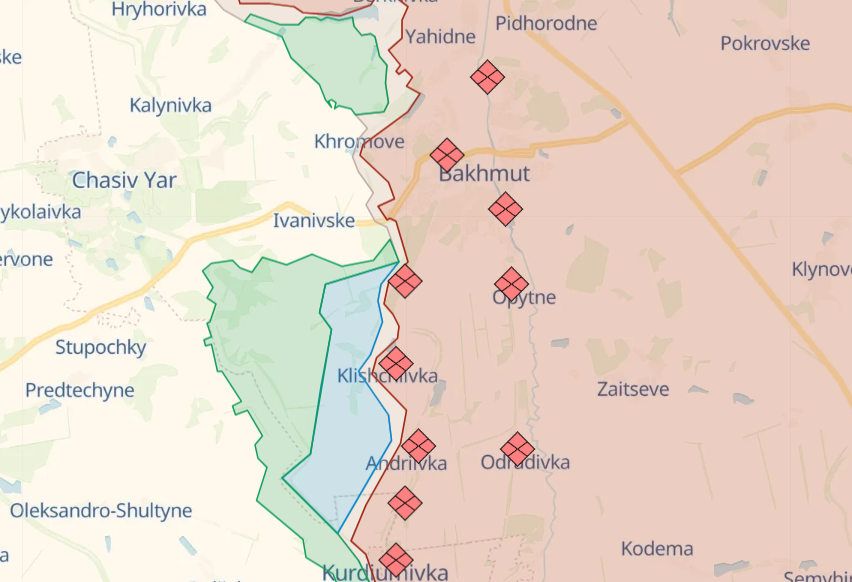
Ukrainian defense forces bypass Bakhmut from the south (photo: deepstatemap.live)
Additionally, Ukrainian forces are advancing in the area of Klishchiivka, 7 kilometers from Bakhmut. Recently, Russian "war correspondents" once again raised the alarm, claiming that their forces supposedly withdrew from the settlement. This information remains unconfirmed for now.
Commander of the Army of the Armed Forces of Ukraine, Oleksandr Syrskii, believes that Bakhmut is already in a semi-encirclement that should be utilized. According to him, all conditions have been created to regain control of the city at a much lower cost than what Russia paid for it. He also laments the Russian advantage in artillery, as our forces can only respond with one shot for every 7-8 of theirs.
Despite the lack of artillery and seemingly modest territorial gains, the Ukrainian forces' progress is evident. If the dynamics continue, the Russians will eventually lose Bakhmut.
"Although I do not see Bakhmut being in a semi-encirclement right now. I do not even understand this definition. I know what encirclement is, operational or tactical encirclement. It's too early to talk about an encirclement, but our forces are certainly creating all the conditions for it," believes Oleksandr Kovalenko.
He adds that the flanking advances should completely enclose the city. If the Russians decide to hold their defense, they will find themselves encircled. If not, they will start retreating. However, this will not happen until they face the threat of losing their logistical arteries in the eastern sector. So far, the Ukrainian forces have not completely cut off the roads to the south and north.
The advance from the southern flank is faster than from the northern. As Serhii Cherevatyi notes, the reason lies in the enemy's good preparation, the presence of water obstacles, and other factors that the military considers better not to disclose. He hints that good news, which may soon come from Bakhmut, should be expected.
Success on the southern front
Representatives of the General Staff report progress in the area of Staromaiorske (Donetsk region) for several consecutive days and consolidation of positions at achieved frontlines. This is the direction toward Berdiansk.
As stated by the Commander of the Operational-Strategic Military Group Tavria, Oleksandr Tarnavskyi, the strike units advanced up to 1.4 km into the enemy's defense. In the area of Staromaiorske, the front line shifted 500 meters southwards. There were also reports of Russian attempts to regain positions on the outskirts of Pryshyb, but all of them failed.
According to the expert Oleksandr Kovalenko, the main objective is to reach Staromlynivks.
"It serves as a stronghold for the Russian occupiers, being the key point of the second defense line in this location. Therefore, the process is quite logical – first capture Staromaiorske, stabilize the flanks and then advance to the second line to engage the main assault groups for a breakthrough," he said.
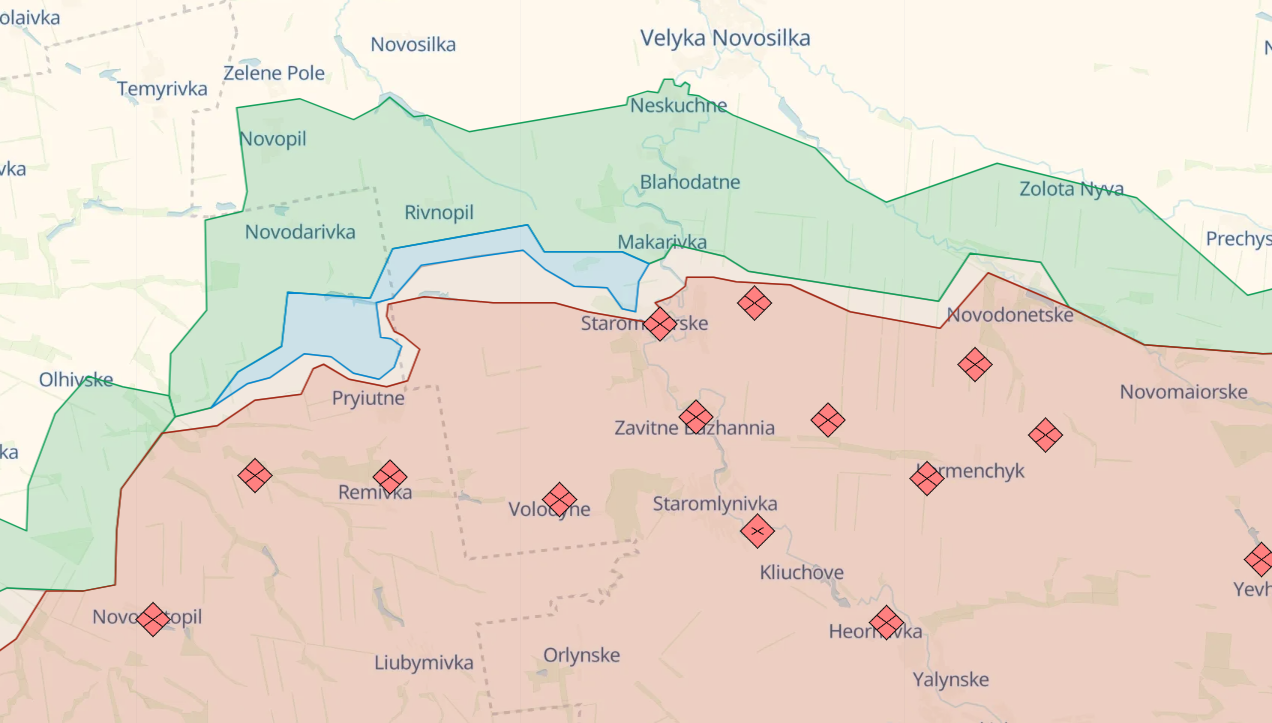
The UAF enhanced positions near Staromaiorske and Pryiutne (photo: deepstatemap.live)
What comes after Staromlynivka depends on the success of this breakthrough. The expert emphasizes that the movement toward Berdiansk, Tokmak, or elsewhere will be determined by the situation on the frontline.
In the Melitopol direction, there are no significant changes for now. The Defense Forces are hindered by dense minefields and fierce resistance from the Russians. According to a representative of the General Staff, Andrii Kovalov, they attempted to return to positions northeast of Robotyne village (Zaporizhzhia region) in recent days but were unsuccessful. At the same time, the enemy is deploying reserves and moving troops.
Experts interviewed by RBC-Ukraine agree that only total air superiority can accelerate the offensive. According to Vladyslav Seleznev, we lack an advantage in aviation and air defense systems in the south. The work of sappers is also hazardous in such conditions.
"I don't think that in the near future, we will be able to cover such a distance to consider the liberation of Melitopol. Besides the dense mining, the enemy is putting up fierce resistance. So our progress will be slow and gradual but undoubtedly unstoppable," added the expert.
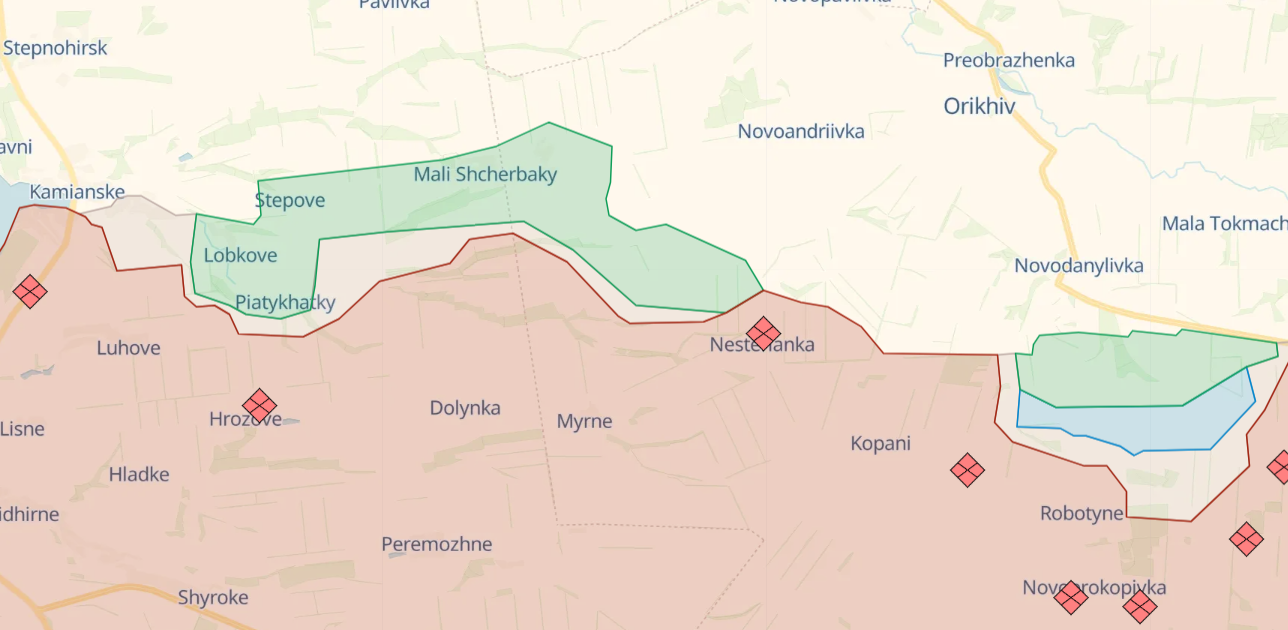
In the Melitopol direction, there are no significant changes for now (photo: deepstatemap.live)
On the other hand, undermining the enemy's combat readiness can also help in dealing with the opponent. It seems that Ukraine is placing a significant emphasis on strikes against targets in occupied Crimea.
Reaching out to Crimea
Last week, on July 17, unknown sea kamikaze drones attacked the Crimean Bridge. It was the second major strike to cause serious damage since the full-scale invasion began. One span of the road section collapsed, but the railway branch was not affected.
Officially, Ukraine does not confirm involvement, but sources from RBC-Ukraine mention a special operation by the Security Service of Ukraine and Naval Forces. This version appears plausible, given the recent statement by the head of the SBU, Vasyl Maliuk, who referred to the October 2022 attack as "one of our accomplishments."
According to analysts from ISW, the bridge damage will have long-term negative consequences for the Russian southern grouping. Vladyslav Seleznev, however, is less optimistic, as the automobile traffic on the bridge was restored the next day.
"The railway connection didn't stop at all, meaning the Russians can supply their brigades with everything they need. As for the road section, the Russians will restore it by the end of the year. Will they manage to do it? No one can say for sure. I am convinced that the more we advance, the more such strikes there will be," he said in an interview with RBC-Ukraine.
A few days after the bridge incident, explosions were reported at the Starokrymsk training ground. There was a large ammunition depot, and the detonations lasted for more than a day. The occupiers evacuated thousands of people, closed roads, and stopped trains. According to the ASTRA Telegram channel, the depot contained tons of artillery shells, mortar mines, grenades, and small arms.
It's worth noting that the facility is about 250 km away from the front line. This means it falls within the theoretical range of high-precision Storm Shadow and SCALP-EG missiles recently acquired by the Ukrainian Armed Forces.
On July 22, unidentified drones attacked an airfield in the Oktyabrske settlement (Krasnohvardiiskyi district). There was an oil base and an ammunition depot. On Monday, a strike hit the depot in the Dzhankoy area, and according to partisan sources, the Onyx anti-ship missiles used by Russia to target Odesa were destroyed. On Tuesday, a repair battalion was attacked, and explosions were reported in the Krasnoperekopsk area and Sevastopol, with helicopters flying and air defense systems engaging.
"I love numbers. Last week, the 'bavovna' (explosions ironically - Ed.) happened on the territory of Crimea at least six times. Deputy Prime Minister for Digital Transformation Mykhailo Fedorov promises that there will be more 'bavovna,' and this is good news. It means that Ukraine has finally formed a fleet of combat drones that will destroy the enemy's military infrastructure," emphasized Seleznev.
Oleksandr Kovalenko clarified that, for example, explosions at depots create problems with proportionally distributing ammunition. In other words, the Russian units in the south risk running out of ammunition.
"The strikes on targets in Crimea will positively impact the capabilities of the Ukrainian Defense Forces to advance in the south. And I am more than confident that this process will continue," concluded the expert.
